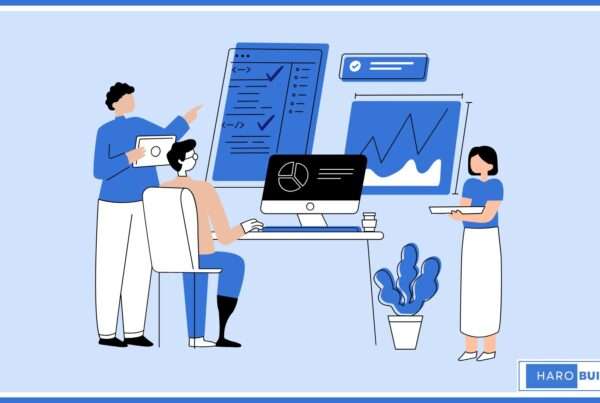
As we enter 2025, small businesses face a fast-changing world. To keep up, embracing new technology is now a must.
The quick changes in technology are changing how small businesses work. They can now make their operations better, improve customer service, and grow. By using new tools and technologies, small businesses can make their processes smoother, stand out from the competition, and grow steadily.
Key Takeaways
- Small businesses must adopt new technology to remain competitive.
- Technology adoption is key to better operations and customer service.
- Using new tech helps small businesses grow and stay ahead.
- The competitive landscape in 2025 calls for innovation and flexibility.
- Embracing technology is essential for lasting growth.
The State of Small Business Technology in 2025
The tech world for small businesses is changing fast. New tools are coming out, and businesses are trying to keep up. They face both chances and hurdles in integrating new technology into their work.
Current Technology Landscape
From 2023 on, tech has gotten more advanced. Small businesses are using tools like predictive analytics and customer service automation. These help them work better and make customers happier.
Key Technology Shifts
More businesses are using AI and automation. This makes their work smoother and helps them make better choices. One company taking the lead is Injectco, which implemented an AI-based lead scoring and nurturing platform to eliminate manual lead vetting.
“It flagged every incoming lead in real time, scored them 0 to 100 based on behavior, and auto-routed high-scorers directly to our booking calendar.” – Kiara DeWitt, CEO at Injectco
This shift helped save her team nearly 9 hours per week — the equivalent of gaining a full-time employee without the payroll costs.
Industry-Specific Trends
Each industry is using tech in its own way. Retail is all about online shopping and making experiences personal. Manufacturing is getting more into IoT.

Competitive Pressures
Small businesses feel the need to keep up with new tech for many reasons. They want to work better, make customers happier, and beat the competition. They do this by implementing tech solutions that bring new ideas.
Why Adopting New Tech Is No Longer Optional
Small businesses must adopt new technology now more than ever. This is due to changing consumer needs and the need for better operations. To meet these demands and stay ahead, using new tech is key.
Market Expectations and Consumer Behavior
Today, people want a unified and tailored experience from businesses. Technology is essential for this. It helps businesses use data and AI to better serve their customers.
Operational Efficiency Requirements
Technology is also vital for making operations smoother. It automates tasks and makes processes more efficient. This helps small businesses save money, work better, and use resources wisely.

Competitive Advantage Through Innovation
Using new technology can make a small business stand out. By adopting new tech, businesses can offer unique products and services. This sets them apart from others.
| Technology | Market Impact | Operational Benefit |
|---|---|---|
| AI and Machine Learning | Personalized customer experiences | Predictive analytics for inventory management |
| Cloud-Based Solutions | Scalability and flexibility | Enhanced collaboration and remote work capabilities |
| IoT and Connected Devices | Smart product offerings | Real-time monitoring and predictive maintenance |
Top Technology Trends Reshaping Small Business Operations
Small businesses are on the verge of a tech revolution. Several key trends are leading the way in 2025. These trends boost efficiency and open new growth paths and ways to engage with customers.
AI and Machine Learning Applications
Artificial Intelligence (AI) and Machine Learning (ML) are at the forefront. They offer small businesses powerful tools to enhance operations. These technologies are used in many ways, including:
Predictive Analytics for Small Business
Predictive analytics, powered by ML, helps small businesses make better decisions. It forecasts trends and behaviors. This is key for managing inventory, planning finances, and finding new opportunities.
Mitchell Cookson, Co-founder of AI Tools Inc., shared how his company uses internal AI agents to analyze user behavior and support tickets.
“These agents summarize trends weekly and recommend actionable insights — what used to take two people 25 hours now runs in the background and lands on our desks Monday morning.”
Customer Service Automation
AI-driven chatbots and virtual assistants are changing customer service. They offer 24/7 support, answer questions, and solve problems quickly. This boosts customer satisfaction and frees up human resources for more complex tasks.
Cloud-Based Solutions
Cloud technology is essential for small businesses. It offers scalability, flexibility, and cost savings. Cloud-based solutions let businesses access important apps and data from anywhere, making remote work and collaboration easier.
IoT and Connected Devices
The Internet of Things (IoT) connects devices and systems for real-time monitoring and control. For small businesses, IoT helps with smart inventory management and personalized customer services.
Blockchain for Small Business Applications
Blockchain technology is becoming popular among small businesses. It improves security, transparency, and efficiency. It’s used for secure transactions, supply chain management, and identity verification.
By embracing innovation and adopting these technologies, small businesses gain big benefits. They see improved efficiency, better customer experiences, and smarter decision-making.
Digital Transformation Strategies for Limited Budgets
Small businesses face a fast-changing tech world. They need to find ways to adopt digital transformation without spending too much. This means investing wisely and getting the most value for their money.
Prioritizing High-Impact Technologies
Small businesses should pick technologies that make a big difference. This could be AI and machine learning for better customer service or cloud-based solutions for easier data sharing. By focusing on these, they can use their resources well.
Subscription vs. Ownership Models
Choosing subscription models can help save money. It means no big upfront costs and always having the latest tech. For example, cloud-based software subscriptions offer flexibility and scalability.
Leveraging Free and Open-Source Solutions
Free and open-source tools are great for small businesses. They save money and often have community support. Tools like open-source CRM systems and free project management tools are examples.
Grant Programs and Tax Incentives
Many governments help businesses with grants and tax breaks for new tech. Small businesses should look into these to lower the cost of digital transformation. Tax credits for tech investments can be a big help.
By using these strategies, small businesses can overcome digital transformation challenges even with tight budgets. It’s about being smart, choosing the right tech, and finding affordable solutions to grow and stay competitive.
Customer-Facing Technologies Driving Growth
Customer-facing technologies are key for small businesses to stay ahead and grow in 2025. They help businesses offer smooth customer experiences, boost engagement, and raise conversions.
Enhanced E-commerce Platforms
Enhanced e-commerce platforms are changing how small businesses sell online. They offer mobile optimization, streamlined checkout processes, and integrated payment gateways. These features improve customer happiness and online sales.
Personalization Technologies
Personalization technologies are vital for small businesses to stand out. They use AI-driven customer insights and dynamic content generation to craft unique customer experiences.
AI-Driven Customer Insights
AI-driven customer insights help businesses understand customer data and behavior. This info is key for tailoring marketing and boosting engagement.
Dynamic Content Generation
Dynamic content generation lets businesses create content that matches individual customers’ tastes. This boosts the chance of a sale.
Omnichannel Communication Tools
Omnichannel communication tools are critical for a smooth customer experience across different channels. They integrate social media, email, and messaging apps. This ensures customers get consistent, timely updates.
Augmented Reality for Retail
Augmented reality (AR) is changing retail by letting customers interact with products in new ways. AR technology boosts engagement and sales for small businesses.
| Technology | Benefits | Examples |
|---|---|---|
| Enhanced E-commerce Platforms | Improved customer satisfaction, increased online sales | Shopify, WooCommerce |
| Personalization Technologies | Highly personalized customer experiences, increased conversion rates | AI-driven customer insights, dynamic content generation |
| Omnichannel Communication Tools | Seamless customer experience across multiple channels | Social media integration, email marketing automation |
| Augmented Reality for Retail | Increased customer engagement, driven sales | Virtual try-on, product demonstrations |
Back-Office Innovations Streamlining Operations
Back-office innovations are changing how small businesses work. They make these businesses more flexible and competitive. By using new technologies, small businesses can work better, save money, and make smart choices.
Accounting and Financial Management Systems
Modern accounting and financial systems are key for small businesses. They help manage money well. These systems give real-time financial insights, do tasks automatically, and follow financial rules. By using these systems, businesses can make their financial work smoother and better manage their money.
Inventory and Supply Chain Management
Good inventory and supply chain management are important for small businesses. Technologies like predictive inventory solutions and supplier management platforms help. They help businesses manage their stock, cut waste, and work better with suppliers.
Predictive Inventory Solutions
Predictive inventory solutions use data and learning to guess demand. This helps businesses keep the right amount of stock. It saves money by avoiding too much stock and ensures they meet customer needs.
Supplier Management Platforms
Supplier management platforms help businesses talk and work better with suppliers. They make sure businesses get what they need on time and reliably. These platforms also help avoid problems in the supply chain.
HR and Employee Management Solutions
HR and employee management solutions change how small businesses handle their team. They make HR tasks easier, from finding new employees to helping them grow. This boosts employee engagement and work quality.
Business Intelligence Dashboards
Business intelligence dashboards give small businesses a clear view of their work. They help make decisions based on data. These dashboards combine data to give actionable insights that help businesses grow.
By using these back-office innovations, small businesses can do better, stay ahead, and grow in a lasting way.
Cybersecurity Essentials for the Modern Small Business
Small businesses have seen many benefits from going digital. But, they also face more cyber threats. It’s key for them to keep up with new security risks as tech changes.
Threat Landscape in 2025
In 2025, small businesses will face a tough and changing threat world. Cyberattacks will get smarter, using AI and tricks to fool people. Small businesses need to stay alert and act fast to keep safe.
Cost-Effective Security Solutions
Good cybersecurity doesn’t have to cost a lot. Small businesses can find affordable ways to protect themselves. Here are some:
- Multi-factor authentication
- Regular software updates
- Employee training programs
- Cloud-based security services
Employee Training and Awareness
Employees are the first defense against cyber threats. Regular training and awareness programs can really help. They should learn about passwords, spotting phishing, and safe internet use.
Compliance and Regulation Considerations
Small businesses must also deal with many cybersecurity rules and standards. Knowing and following laws like GDPR and CCPA is important. It helps avoid legal trouble and keeps customers’ trust.
| Cybersecurity Measure | Cost Effectiveness | Impact on Security |
|---|---|---|
| Multi-factor Authentication | High | Significant |
| Regular Software Updates | High | Moderate |
| Employee Training | Moderate | High |
| Cloud-based Security | Moderate | Significant |
By knowing the threats, using smart security, training staff, and following rules, small businesses can boost their cybersecurity. This is part of their digital transformation and technology implementation strategy.
Strategies for Successfully Adopting New Tech
For small businesses, embracing new technology is now a must. They need to find ways to adopt and use new tech effectively.
Technology Assessment and Planning
Starting with a detailed tech assessment is key. It means checking current systems, finding what’s missing, and picking the right tech for goals. Careful planning makes sure new tech fits with business plans and grows with the company.
Implementation Best Practices
Getting new tech right is all about good implementation. This includes:
- Phased Rollout Approaches: Slowly adding new tech to avoid problems and make adjustments.
- Employee Onboarding Techniques: Giving full training to make sure staff knows and uses new systems well.
Phased Rollout Approaches
Phased rollout helps manage risks. It lets businesses test and tweak their plans before going all in.
Employee Onboarding Techniques
Good training is essential for tech success. Companies should invest in detailed onboarding. This should include practical training and support to help staff use new tech well.
Measuring ROI on Technology Investments
To show the value of new tech, businesses need to track ROI. They should look at how new tech improves productivity, saves costs, and boosts sales.
Overcoming Common Adoption Challenges
But, adopting new tech can be tough. Issues like resistance, lack of skills, and integration problems can arise. To beat these, businesses should encourage innovation, keep training up, and choose tech that works with what they already have.
Case Studies: Success Stories of Tech-Forward Small Businesses
Small businesses are making big strides by using new tech. They’re using advanced systems to grow, work better, and serve customers better.
Retail Transformation
In retail, small shops are using AI chatbots and augmented reality. For example, a New York boutique used AI to manage stock. This led to a 25% sales boost thanks to better stock and personalized advice.
“The integration of AI in our inventory management has been a game-changer. It’s allowed us to predict demand more accurately and reduce waste.” – Emily Chen, Owner, Trendy Boutique
Service Industry Innovation
Service businesses are also seeing benefits from new tech. A California dental clinic used a cloud system for patient management. This cut admin costs by 30% and made patients happier.
Manufacturing Modernization
Small makers are using IoT and predictive maintenance. A car parts maker in the US used IoT to cut downtime by 40% and boost efficiency.
Predictive Inventory Solutions
Predictive inventory helps small businesses in retail and manufacturing. It uses data to guide stock decisions, reducing waste.
Supplier Management Platforms
Supplier platforms help small businesses manage suppliers and track shipments. A small food company in the US cut supply chain costs by 20% with such a platform.
| Industry | Technology Adopted | Benefits Realized |
|---|---|---|
| Retail | AI-powered inventory management | 25% increase in sales |
| Service | Cloud-based patient management | 30% reduction in administrative costs |
| Manufacturing | IoT-based monitoring system | 40% reduction in equipment downtime |
Professional Services Digitization
Professional services firms are also going digital. A Texas law firm used a digital system for documents. This made clients happier and cut document search time by 50%.
These stories show how new tech can help small businesses grow and improve. By choosing the right tech, they can stay ahead and succeed in the long run.
Conclusion: Preparing Your Business for Continued Technological Evolution
Technology keeps changing, and small businesses must keep up to stay ahead. They need to adopt new technologies to compete. By being innovative and choosing the right tech, they can succeed for a long time.
For small businesses, using new technology is essential. They must understand the tech world and change quickly. This helps them meet market needs and customer wants.
Small businesses can grow and work better by focusing on key technologies. They should use affordable solutions and improve both customer service and back-office work. As tech changes, businesses ready to adopt new tech will lead the way to success.



